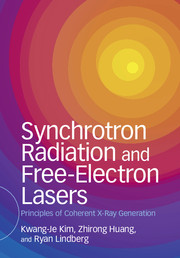Book contents
- Frontmatter
- Contents
- Preface
- Conventions and Notation
- 1 Preliminary Concepts
- 2 Synchrotron Radiation
- 3 Basic FEL Physics
- 4 1D FEL Analysis
- 5 3D FEL Analysis
- 6 Harmonic Generation in High-Gain FELs
- 7 FEL Oscillators and Coherent Hard X-Rays
- 8 Practical Considerations and Experimental Results for High-Gain FELs
- Appendix A Hamilton's Equations of Motion on Phase Space
- Appendix B Simulation Methods for FELs
- Appendix C Quantum Considerations for the FEL
- Appendix D Transverse Gradient Undulators
- Further Reading
- Index
- References
3 - Basic FEL Physics
Published online by Cambridge University Press: 06 April 2017
- Frontmatter
- Contents
- Preface
- Conventions and Notation
- 1 Preliminary Concepts
- 2 Synchrotron Radiation
- 3 Basic FEL Physics
- 4 1D FEL Analysis
- 5 3D FEL Analysis
- 6 Harmonic Generation in High-Gain FELs
- 7 FEL Oscillators and Coherent Hard X-Rays
- 8 Practical Considerations and Experimental Results for High-Gain FELs
- Appendix A Hamilton's Equations of Motion on Phase Space
- Appendix B Simulation Methods for FELs
- Appendix C Quantum Considerations for the FEL
- Appendix D Transverse Gradient Undulators
- Further Reading
- Index
- References
Summary
This chapter provides a somewhat qualitative introduction to free-electron laser physics. After a brief introduction to how FELs fit in with other sources of coherent radiation and how FEL amplification can work, we derive in Section 3.2 the 1D equations of motion for the electrons in an FEL. We find that the electrons move in a pendulum-type potential formed by the transverse undulator and radiation fields. We then discuss the FEL particle dynamics in the limit that the gain is small in Section 3.3, for which we can approximate the electric field as constant so that we do not need Maxwell's equations; this regime of operation is most suited to oscillator FELs that we cover in more detail in Chapter 7.We compute the FEL gain in the small-signal limit, and qualitatively describe the FEL when the radiation power is large. In Section 3.4 we include the self-consistent evolution of the radiation, which extends our equations to include high-gain FELs that experience exponential gain. We show how the basic physics of small signal gain and exponential growth can be derived in terms of three collective variables, and how the FEL Pierce parameter ρ plays a central role in determining the output characteristics. Finally, we make a brief introduction to self-amplified spontaneous radiation, which we will describe more thoroughly in Chapter 4.
Introduction
Coherent Radiation Sources
Powerful, coherent sources are familiar for wavelengths longer than 1 mm – the microwave devices – and also for wavelengths between a few microns and approximately 0.1 μm – lasers based on atomic and molecular transitions. Microwave devices (including magnetrons, klystrons, and, increasingly, solid-state devices) have found numerous applications including radar, accelerating structures, and food preparation. The applications of lasers operating in the IR, visible, and near UV are incredibly numerous and diverse: uses vary from precise measurements of time and distance to cutting and etching on both large and nano-scales to addressing single atoms for quantum computing.
- Type
- Chapter
- Information
- Synchrotron Radiation and Free-Electron LasersPrinciples of Coherent X-Ray Generation, pp. 74 - 103Publisher: Cambridge University PressPrint publication year: 2017

